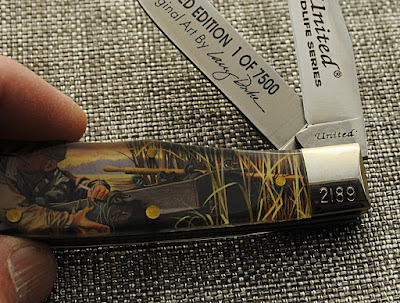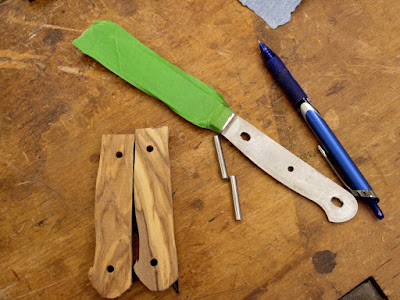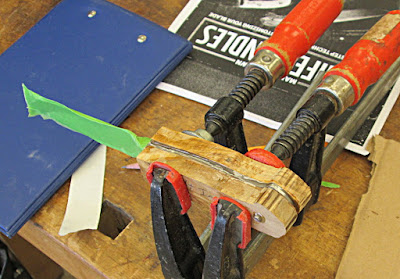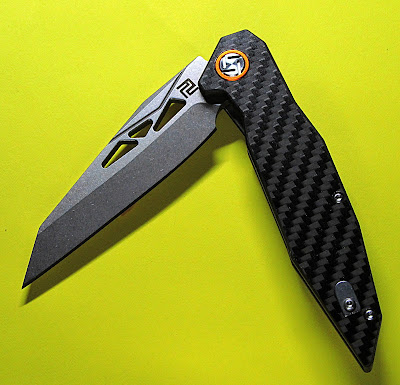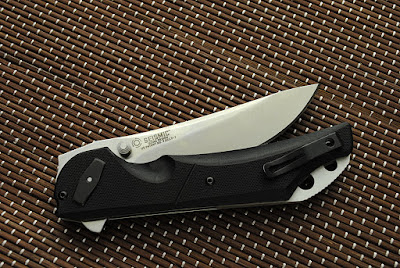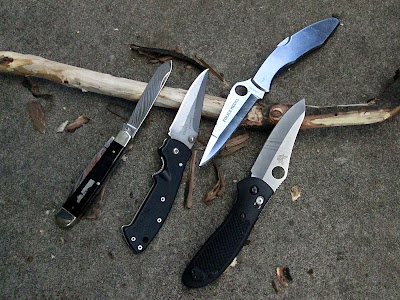To say that the bedrock of our society is steel
would not be an understatement. We use
steel everyday in one or another way.
Understanding steel can be complicated, but we can
get the basic ideas without too much pain.
Here’s the first part: Steel is
an alloy of the elements iron and carbon.
Steel making starts with rust; different iron
oxides are collected and heated with carbon to reduce the iron oxide to metal.
I can imagine primitive man poking through the remnant of a camp fire looking
for embers and finding something very different.
Two of the earliest forms were wrought and cast
iron. Both are crude, slag loaded, high carbon
content forms of steel. They still have
roles to play in modern society.
Modern steel has from 0.05 to 2.1% carbon, and
this is the core idea behind modern steels.
Molten iron can in fact dissolve more carbon than it can keep suspended
in solid form. Depending on how much is
present and how fast the metal cools, wondrous things happen. One is the formation of iron carbides. These are very small, very hard pieces of
grit that help strengthen steel. Other
elements form even better carbides, like chromium or vanadium.
The second part we need to understand is the
formation of three different arrangements of iron and carbon. These are ferrite, austenite and martensite.
Ferrite has the least tolerance for carbon in the crystalline
solid. Austenite has a slightly
different crystal structure and slightly higher tolerance. Martensite holds even more carbon, but it is forced
to drastically change its size and shape of its crystal habit.
Each of the three arrangements has different
physical properties.
Heat treatment relies on an understating of how
the steel alloy changes with temperature, cooling rates, cycling rates and
trace elements. This process involves
complicated heating, cooling, annealing and aging steps. Don’t believe everything you see on Forged in
Fire about quenching red hot steel.
Quite a few steps are left out.
Here’s a rather simple annealing and tempering process
Heat to
1600F(870C), hold 2 hours, slow cool 30F (15C)/hour maximum to 1000F(540C),
then air or furnace cool. Hardness BHN 225/255.
Followed by tempering: Heat to 1000F(540C) minimum recommended. Double
tempering required and triple tempering recommended when hardening from
2100F(1150C) or higher. Air cool to room temperature between tempers.
Steel is a dynamic, evolving product and any list
is almost assured to be incomplete. Not
every steel is suitable for making blades.
Types of steel used by different manufacturers are subject to change
without informing me. In fact, much of
this information about steels currently in use by specific manufacturers is
wrong.
Lastly, steel formulas are given as percentage of
alloying elements. The actual percent
iron is calculated by difference.
Steels
5160, a
spring steel, popular for forging swords
and large knives. High toughness and
good wear resistance. Popular sword
manufacturers that use 5160 spring steel are Hanwei Forge and Generation 2.
5160 spring steel is mainly used on medieval type swords.
6150, a
chromium-vanadium alloy. Similar to 4140, 6150 is a tough steel with good
impact resistance that can be hardened to the mid-50s on the HRC scale. While a
good material for swords or tomahawks, it is less than ideal for most knives
because of its limited attainable hardness.
V-toku1 /
V-toku2, alloyed steel with W /Cr's original characteristics.
Tool steels
Tool steel grades used in cutlery are: A, D, O, M,
T, S, L, W.
A2 is a
steel that trades wear resistance for toughness. It is used in custom made
fighting knives by makers such as Phill Hartsfield, Rob Criswell, Mike Snody
and John Fitzen (Razor Edge US) and one of the latest to standardize his
camp/survival knives in A2 tool steel is Aaron Gough from Gough custom, Canada.
A2 was the standard baseline steel used
by Bark River Custom Knives. A2 is used as the standard tool steel for Black
Wolf Knives range of Hunting Knives by Marc Godwin, Japan
A6,
this grade of tool steel air-hardens at a relatively low temperature
(approximately the same temperature as oil-hardening grades) and is
dimensionally stable. Therefore, it is commonly used for dies, forming tools,
and gauges that do not require extreme wear resistance but do need high
stability.
A8, C 0.55%
Mn 0.30% Si 0.30% Cr 5.00% Mo 1.25% W 1.25%
A10,
this grade contains a uniform distribution of graphite particles to increase
machinability and provide self-lubricating properties. It is commonly used for
gauges, arbors, shears, and punches.
D2, is
a high carbon, high chromium die steel and is the highest carbon alloy tool and
die steel typically used in knife making. With a chrome content of 12.00%, some call it
a "semi-stainless", because of the lack of free chromium, (as
compared to the chromium reacted to form chromium carbides), even though it is
defined by ASM and ANSI as stainless which contains at least 11.5% by weight of
chromium. It deserves the informal myth:
"D2 knives hold an edge forever, and are impossible to sharpen." While not as tough as premium carbon steels,
it is much tougher than premium stainless steels. D2 knife blades were popularized by Jimmy
Lile, and later by Bob Dozier.
O1, a
popular forging steel. Good wear resistance and excellent edge retention. It is
a very tough, but not as much as 5160. It is most commonly used by Randall Knives,
Mad Dog Knives, and many other custom knife makers.
M2, is
slightly tougher than D-2. As a high speed tool steel, it is capable of keeping
a tempered edge at high temperatures generated in various machining processes.
However, it isn't used as widely in factory production knives, as CPM M4 has
become more popular. Custom knife makers still use it for knives intended for fine
cutting with very thin edges.
M4, see
High speed CPM REX M4.
S1, a
shock-resistant medium carbon tool steel which combines moderate hardness with
good impact toughness. Carbon content 0.40 - 0.55%.
S7, a
shock-resistant medium carbon tool steel, with outstanding impact toughness and
high strength, along with medium wear resistance. It has maximum shock
resistance and high compression strength, which gives it good deformation
resistance in use, while retaining good toughness.
W1, a
water hardening tool steel. High carbon content.
W2, a
tool steel that holds its edge quite well but not very tough. Has a carbon
content of 1.5. Most readily available
W2 has a carbon content of no more than 1-1.1%. It can be left at high hardness
levels (it can attain a quenched hardness of 67 Rc) and still be quite tough
especially in larger knives with thicker spines as the core of the thick
portion of the blade does not attain full hardness because of the shallow
hardening nature of the steel. Bill Moran considered it to be almost as tough
as 5160, but it was unavailable for a period of time. W2 is one of the carbon
steels that can produce a nice Hamon in heat treating.
SK3, SK4,
SK5 - Japanese carbon steels. SK stands for "Steel Kougu" meaning
"Steel Tool". The lower number indicates fewer impurities.
CPM Tool
Steel Crucible Industries produces
Crucible Particle Metallurgy (CPM) tool steels using a powder metal forge
process.
CPM 1V,
a proprietary steel, very high toughness, several times higher than A2 with same
level of wear resistance.
CPM 3V
is a proprietary steel, very high toughness, less than CPM 1V, but more than
A2, and high wear resistance, better than CPM 1V. Used by several custom knives
makers and factories, including Jerry Hossom, Mike Stewart [Bark River], Reese
Weiland, Nathan Carothers, and Dan Keffeler. Makes good choice for swords and
large knives.
CPM 4V
a proprietary steel, high-impact toughness and a very good wear resistance.
Gaining popularity in Bladesports Competition Cutting knives.
CPM 9V,a
modification of CPM 10V with lower carbon and vanadium to improve toughness and
heat check resistance.
CPM 10V
(AISI A11), highly wear-resistant tool steel, toughness comparable with D2 tool
steel. Currently used by a few custom knife makers, including Christopher
"Big Chris" Berry. Phil Wilson pioneered the use of CPM 10V and
numerous other CPM steels in sporting knives.
CPM 15V,
a proprietary steel, extremely high wear-resistant tool steel, thanks to 14.5%
Vanadium content. Found only in custom knives.
CPM CRU-WEAR,
a proprietary steel designed as a CPM upgrade to conventional Cru-Wear and D2
steels, it offers better wear resistance, toughness, and hardness.
CPM REX M4
is a special purpose high speed steel designed to give high wear resistance in
tools. Its high vanadium and carbon content provide for superior resistance to
cratering and wear, exhibiting better wear resistance than M2 or M3. C 1.30%, Cr 4.00%, W 5.50%, V 4.00% and Mo
4.50%.
Chrome
steel
Chrome steel is one of a class of non stainless
steels which are used for applications such as bearings, tools and drills.
AISI 52100,
ball bearing steel. In terms of wear resistance, a little better than that of
the O1 steel, however 52100 is also tougher. It has very fine carbides, which
translates into high edge stability. Used by many custom makers, Swamp Rat
knives uses 52100 steel under the name SR101. Also referred to as 100 Cr 6/102 Cr6 as per
ISO nomenclature and conforms to BS grade En31.
SUJ2,
Japanese equivalent to AISI 52100 steel.
Semi-stainless
steels
Steels that did not fit into the stainless
category because they may not have enough of a certain element, such as
chromium.
V-Gin1,
a fine-grained steel with Mo, V for the best effect of Cr.
V-Gin2,
more Cr is added for better corrosion resistance.
V-Gin3B,
more Cr is added for better corrosion resistance.
Stainless
steel
Stainless steel is a popular class of material for
knife blades because it resists corrosion and is easy to maintain. But
stainless steels are not impervious to corrosion or rust. In order for a steel to be considered
stainless it must have a chromium content of at least 10.5%.
154CM /
ATS-34 steels These two steels are
practically identical in composition. They were introduced into custom knives
by Bob Loveless circa 1972.
154CM is
produced by Crucible Industries. It was once used extensively by Benchmade
Knife Company and many others.
CPM 154
is identical to 154CM in composition, however it is produced by Crucible using
CPM Process bringing all the benefits of Particle Metallurgy technology.
ATS-34
is produced by Hitachi Metals.
The latter two are considered premium cutlery
steels for both folding knives and fixed blades.
400 series
The 400 series remains one of the most popular
choices for knife makers because it is easy to sharpen and it is resistant to
corrosion and is magnetic.
410 is
a hardenable, straight-chromium stainless steel which combines superior wear
resistance with excellent corrosion resistance.
416 is
very similar to 410 with the addition of sulfur to improve machinability.
420 has
more carbon than 410, but less than 440. As such it is softer than 440, but has
a higher toughness.
420
series contain several types with various carbon content between 0.15% and 0.40%. This steel grade is widely used to make high
end razor blades, surgical scalpels etc. It obtains about 57 HRC after suitable
heat treatment. 420HC (420C ) is a higher carbon content 420 stainless. The HC
stands for "high carbon" and it can be brought to a higher hardness
than regular 420 and should not be mistaken for it. Buck Knives and Gerber Knives
use 420HC extensively. 420A ( 420J1 ) and 420B ( 420J2 ) are economical, highly
corrosion resistant stainless steel grades. Knife manufacturers use this
material in budget knives, also in diving knives due to its high resistance to
corrosion.
440
series has three types, 440A, 440B and 440C. 440A is a relatively a low cost, highly corrosion resistant
stainless steel. In China, Ahonest ChangJiang Stainless steel developed 440A
modified 7Cr17MoV, by adding more element vanadium. 440B is almost identical to 440A, but has a
higher carbon content range compared to 440A. 440C is considered a high-end stainless steel.
It is very resistant to corrosion and is one of the most common stainless alloys
used for knife making. The once ubiquitous American Buck Model 110 Folding
Hunter was made of 440C before 1981. 440C has highest carbon content in 440
group. Böhler n695 is equivalent to
440C. Knife blades specified as being "440" can typically be assumed
to be the lower hardness 440A grade.
AUS series
The AUS stainless steel series is produced by
Aichi Steel Corporation of Japan. They differ from the AISI 4xx series because
they have vanadium added to them. Vanadium improves the wear resistance, toughness,
and ease of sharpening. In the alloy
name the appended 'A' indicates the
alloy has been annealed.
AUS-6 (6A)
is comparable to 440A with a carbon content close to 0.65%. It is a low cost
steel, slightly higher wear resistance compared to 420J. A typical formula would be C 0.6%, Cr 14%, V 0.17%
AUS-8 (8A)
is comparable to 440B with a carbon content close to 0.75%. AUS-8 is often used instead of 440C. SOG knives
uses AUS-8 extensively.
AUS-10 is
comparable to 440C with a carbon content close to 1.10%. It is slightly tougher than 440C.
CPM SxxV
series are Crucible Industries stainless steels produced using CPM process.
CPM S30V,
on the lower end of the SxxV steels, it has a carbon content of 1.45%. However,
S30V is still considered to be a superior choice for knife making. CPM S30V is
used in a wide range of ZT knives.
CPM S35VN
is a martensitic stainless steel designed to offer improved toughness over CPM
S30V. It is also easier to machine and polish than CPM S30V. It is used in many
high end kitchen knives including those by New West Knifemakers.
CPM S60V
(formerly CPM T440V) (discontinued), very rich in vanadium. CPM S60V has a
carbon content of 2.15%. It was an
uncommon steel, but both Spyderco and Kershaw Knives offered knives of this
steel, Boker still offers folders made from CPM S60V.
CPM S90V
(formerly CPM T420V) has less chromium than S60V, but has almost twice as much
vanadium. S90V's carbon content is also higher, resting around 2.30%.
CPM S110V
has higher corrosion resistance than S90V and marginally better wear
resistance. The additional corrosion resistance while retaining all the
benefits of S90V makes this steel extremely desired for kitchen cutlery.
CPM S125V
contains 3.25% carbon, 14% chromium and 12% Vanadium and other alloying
elements. Exceptionally high wear
resistance, making it difficult to process and machine for knifemakers. At first only used in custom knives, it has
been utilized by larger manufacturers more recently in very limited quantities.
VG series Japanese
stainless steels, manufactured by Takefu Special Steel.
VG-1,
Takefu stainless steel. Popular steel in Japanese kitchen knives. C 1%, Cr 13.0-15.0 %, Mo 0.3 %. During
forging, Mo and Cr form hard double carbide bonds, which help improve the
abrasion and corrosion resistance of the steel.
VG-2,
middle-carbon Mo stainless blade steel.
VG-5, synergic
effect of Mo and V makes carbide finer.
VG-7/VG-8W,
strengthens substrate and improves tempering performance.
VG-10(B/W),
Takefu stainless steel, similar composition to VG-1 but also contains cobalt
and vanadium. Good wear resistance and rust resistance.
Due to small Vanadium content VG-10 has finer
grain content compared to VG-1. Cobalt and Nickel improve toughness. Overall,
it has better edge stability compared to VG-1. VG-10 is widely used in Japanese
kitchen knives, several manufacturers use it in various folders and fixed blade
knives, including Spyderco, Cold Steel and Fallkniven.
San-mai,
A composite steel used to make high end knives. The core is VG-1 and the
outside layers are 420j for good rust resistance. San-mai
is also the term applied to a sandwich of a core steel with a different,
usually softer, steel on both sides.
CTS series American
stainless steels produced by Carpenter Technology using vacuum melt technology.
CTS-BD1,
is a high-carbon chromium steel that provides stainless properties with high
hardness and excellent wear resistance.
CTS-20(CP),
offers superior edge retention and surface finish, an ability to be machined to
a fine edge, and consistent heat-treatability from lot to lot.
CTS-40C(CP),
a powder metallurgy, high-carbon chromium stainless steel designed to provide
stainless properties with maximum hardness.
CTS-TMT,
a hardenable martensitic stainless steel that combines improved corrosion
resistance over Type 410 stainless with hardness up to 53 HRC and improved
formability over 17Cr-4Ni.
CTS-XHP,
a powder metallurgy, air-hardening, high carbon, high chromium,
corrosion-resistant alloy. It can be considered either a high hardness 440C
stainless steel or a corrosion-resistant D2 tool steel.
CrMo/CrMoV
Series Chinese and American
stainless steels; the manufacturers are unknown with the exception of 14-4CrMo
which is manufactured by Latrobe Specialty Metals.
(Sorted by first number.)
14-4CrMo,
manufactured by Latrobe Specialty Metals. A wear resistant, martensitic
stainless tool steel that exhibits better corrosion resistance than 440C
stainless steel.
2Cr13,
belongs to 420 grade series, very basic. EN 1.4021 / DIN X20Cr13, widely used
in economic cutting tools, 50HRC max after heat treatment.
3Cr13,
in 420 grade series, it contains 420A 420B 420C 420D. 3Cr13 steel is 420B, EN
1.4028 / DIN X30Cr13, 52HRC-ish after heat treatment.
3Cr13MoV,
made by adding more elements molybdenum and vanadium to the 420J2-3Cr13
formula.
4Cr13, EN
1.4034 / DIN X46Cr13, 420C stainless steel, it obtains about 55-57HRC.
4Cr13Mo, EN
1.4419 / DIN X38CrMo14, developed based on GB 4Cr13 / DIN X46Cr13 by adding
elements Molybdenum.
4Cr14MoV,
EN 1.4117 / DIN X38CrMoV15, good enough to make kitchen knives.
5Cr15MoV,
some knives manufacturers define as 5Cr13MoV, the hardness could be 55-57 HRC.
It's widely used to make kitchen knives, high-end scissors, folding knives and
hunting knives etc.
6Cr14MoV,The
Patented name applied by Ahonest Changjiang Stainless steel Co., Ltd. Similar
stainless steel grade 6Cr14 (6Cr13)/420D which does not contain molybdenum and
vanadium used to make razor blades, surgical scalpels etc.
7Cr17MoV,
440A modified with more vanadium elements. The benefits of Vanadium:
Increases strength, wear resistance, and increases toughness the recommended
hardness about 55/57 HRC.
8Cr13MoV
& 8Cr14MoV, similar to AICHI AUS-8, an excellent value priced steel for
its performance.
9Cr13MoVCo,
9Cr14MoV. Chinese-made steels that are similar to 440B but with a higher
carbon, cobalt and vanadium content to add more strength to the blade. Uses
include high end barber scissors, hunting knives etc.
9Cr18MoV,
440B modified, a higher end Chinese stainless steel used mostly in high-end
barbering scissors and surgical tools.
9Cr19MoV,
used in items such as the Ultimate Pro Bear Grylls Survival knife.
99Cr18MoV,
440C modified. Developed by jaktkit and Ahonest Changjiang in cooperation.
Uses ESR technology and hot forging. This improves its work performance,
especially toughness, and edge holding ability.
Sandvik
series
6C27, a
common knife steel grade with good corrosion resistance and low hardness,
mainly used in applications where the need for wear resistance is low.
7C27Mo2,
Generally the same properties as Sandvik 6C27, but with improved corrosion
resistance.
12C27,
a grade with high hardness and good wear resistance. Takes very keen edge with
moderate edge retention.
12C27M,
another Swedish stainless razor steel. A very pure, fine grained alloy. A grade
with good wear resistance and good corrosion resistance, well suited for the
manufacture of kitchen tools.
13C26,
also known as a Swedish stainless razor steel. Generally the same properties as
Sandvik 12C27, but with slightly higher hardness but less corrosion resistant.
The Swedish steel maker Uddeholm AB also makes a virtually identical razor
steel composition known as AEB-L, which they patented in 1928. Swedish razor
steel is a very pure, fine grained alloy which positively affects edge holding,
edge stability and toughness.
14C28N,
designed by Sandvik at Kershaw's behest to have the edge properties of 13C26
but with increased corrosion resistance by adding nitrogen and chromium.
19C27,
a grade with very high hardness and wear resistance.
DSR series Daido stainless tool steels used for
kitchen knives and scissors.
DSR1K6(M),
similar to AUS-6 and VG2
DSR7F,
used for high-hardness cutting parts.
DSR10UA,
used for small scissors.
High Chrome
/ High Vanadium Stainless The
following Powder Metallurgy steels contain very high levels of Chromium, which
at 18%-20% produces a steel matrix that is highly corrosion resistant. They
also contain relatively high levels of Vanadium (3.0% to 4.0%), producing a
high volume of Vanadium-Carbides in the steel matrix, associated with excellent
abrasion resistant edge holding.
M390 -
Bohler M390 Microclean. Third-generation powder metallurgy technology
steel. Developed for knife blades requiring good corrosion resistance and very
high hardness for excellent wear resistance. Chromium, molybdenum, vanadium, and
tungsten are added for excellent sharpness and edge retention. Can be polished
to an extremely high finish. Hardens and tempers to 60-62 HRC, where it best
balances edge holding and toughness. Due to its alloying concept, this steel
offers extremely high wear resistance and high corrosion resistance.
CPM-20CV
- essentially Crucible's version of M390.
CTS 204P
- essentially Carpenter's version of M390.
Elmax -
Produced by Bohler-Uddeholm, Elmax is a through-hardening corrosion resistant
mold steel using third-generation powder metallurgy process. Often said to be
superior to CPM S30V and CPM S35VN for edge retention and ease of sharpening. Elmax is very similar to M390, CPM 20CV, and
CTS 204P, but has somewhat lower Vanadium content, and lacks any Tungsten
content.
Other
stainless
ATS-55,
produced by Hitachi Metals.[29] Has lower molybdenum content than ATS-34, is
less wear-resistant than ATS-34 and has been reported to be also less
rust-resistant than ATS-34.
BG-42
Slightly higher in carbon, chrome and moly than ATS-34. Must be forged and heat
treated at very high and exact temperatures. Can be used at very high hardness,
such as RC 64-66. Not supposed to be brittle, but high alloy steels usually
are. Very expensive and hard to work. It is a martensitic stainless high speed
steel that combines the tempering, hot hardness and hardness retention
characteristics of M50 high speed steels, with the corrosion and oxidation
resistance of Type 440C stainless. Although often used for aerospace bearings
and other critical applications, its excellent wear resistance and corrosion
resistance makes it a superior choice for use in cutlery applications.
Kin-2,
Medium-carbon Mo, V stainless blade steel.
Cowry-X
is produced by Daido steel using PM process. Contains 3% carbon, 20% chromium,
1.7% molybdenum and Less than 1.00% vanadium. Other elements are not published or may not
even exist. Used by Hattori knives in their kitchen knives KD series.
ZDP-189
is produced by Hitachi steel using PM (power metal) process. It contains 3%
carbon and 20% chromium and contains tungsten and molybdenum. Used by several custom knife makers and
factory makers including Spyderco and Kershaw in the limited run of the Ken
Onion Shallot folders. The Henckel Miyabi line markets this steel with the name
"MC66".
R2 is a
PM steel made by Kobe Steel Japan (Kobelco). It is also known as SG2 (Special
Gold 2) when it is marked by Takefu Specialty Steel.
SRS-15
a High Speed Tool Steel (HSS) where the 15 represents 1.5% C. One of the
earliest known Japanese "super steels" the maker is unknown. A SRS-13
with 1.3% C also exists.
High-speed
steel
CPM REX series
CPM REX M4
HC (AISI M4) is a high speed tool steel produced by Crucible using CPM
process. M4 has been around for a relatively long time, lately entering custom
and high end production knives. Popular
steel for use in Bladesports Competition Cutting knives.
CPM REX 121
is a new high vanadium cobalt bearing tool steel designed to offer a
combination of the highest wear resistance, attainable hardness, and red
hardness available in a high-speed steel.[53]
CPM REX 20
(HS) is a cobalt-free super high speed steel made by the CPM process.
CPM REX 45
(HS) is an 8% cobalt modification of M3 high speed steel made by the CPM
process. As of September 2018 this steel was used in some limited-run
production knives from Spyderco.
CPM REX 54
HS is a cobalt-bearing high speed steel designed to offer an improvement in
the red hardness of the popular M4 grade, while maintaining wear properties
equivalent to M4.
CPM REX 66
(HSS)is a super high speed steel made by the CPM process.
CPM REX 76
(HSS) is a super high speed steel made by the CPM (Crucible Particle
Metallurgy) Process. It is heat treatable to HRC 68-70. Its high carbon,
vanadium and cobalt contents provide abrasion resistance comparable to that of
T15 and red hardness superior to that of M42.
CPM REX 86
(HSS) is a super high speed steel made by the CPM process. It has a
combination of high attainable hardness capability (68-70 HRC), red hardness,
and abrasive wear resistance for difficult machining applications while still
maintaining good fabricating and toughness characteristics. The composition is
designed to provide a balance of vanadium-rich MC and tungsten-molybdenum-rich
M6C primary carbides.
CPM REX
T15(HSS) is a super high speed steel made by the CPM process. It is a
tungsten type high speed containing high vanadium for excellent abrasion
resistance, and cobalt for good red hardness, and is used for cutting difficult
to machine materials where high frictional heating is encountered.
Others
Maxamet
is marketed by its manufacturer as a middle-ground between high-speed steel and
cemented carbide. Carpenter claims Maxamet has improved hardness and wear
resistance over high-speed steels while being tougher than cemented carbides.
As of early 2018, it is used in several production knives from Spyderco.
Super
stainless steels
The steels in this category have much higher
resistance to elements and corrosion than conventional stainless steels. These
steels are austenitic and non-magnetic. They are used in knives designed for
use in aggressive, highly corrosive environments, such as saltwater, and areas
with high humidity like tropical forests, swamps, etc. These steels can contain
26% to 42% chromium as well as 10% to 22% nickel and 1.5 to 10% of titanium, tantalum,
vanadium, niobium, aluminum silicon, copper, or molybdenum etc., or some
combination thereof.
H1,
produced by Myodo Metals, Japan. Used by Spyderco in their salt water/diving
knives. Benchmade used it as well, later replaced with X15TN.
X15Tn, French
steel patented by Aubert&Duval, originally designed for medical industry
and jet ball bearings . This is a Martensitic stainless steel, with a high
nitrogen content, remelted for optimum structure and properties. Used by
Benchmade in their salt water/diving knives.
N680,
Bohler-Uddeholm steel , is also a Martensitic stainless steel, very similar to
X15TN. Used by Benchmade in their salt water/diving knives.
N690CO
an Austrian stainless steel hardened to the high Rc50 range. Currently found in
Spyderco's Hossom knives and the recently discontinued Italian-made Volpe. TOPS
knives also used it in their C.Q.T magnum 711 knife. Also used extensively by
Fox Knives Military Division, Extrema Ratio and Steel Will Knives.
Vanax,
produced by Uddeholm, is a relatively new, 3rd generation powder metallurgy
blade steel in which carbon is largely replaced by nitrogen. This results in a
steel with extreme corrosion resistance, excellent edge holding, yet it is
fairly easily resharpened while containing a relatively high carbide volume for
abrasive cutting edge retention.
LC200N
(aka Z-FiNit) produced by Zapp
Precision Metals, is a high nitrogen alloyed tool steel which exhibits superior
corrosion resistance combined with high toughness even at hardness up to 60
HRc. Spyderco uses this steel in several of their knives.
Carbon
steel is a popular choice for rough use knives. Carbon steel used to be
much tougher, much more durable, and easier to sharpen than stainless steel. This is no longer true. Carbon steels lack the chromium content of
stainless steel, making them susceptible to corrosion. They have less carbon
than typical stainless steels do, but it is the main alloy element. They are
more homogeneous than stainless and other high alloy steels, having iron carbide
as the sole grain stabilizer. The bulk material is harder than stainless,
allowing them to hold a sharper and more acute edge. But they dull quicker because they lack sufficient
hard carbides to prevent crystal deformation and slipping. This also makes them
quicker to sharpen. Carbon steel is well known to take a sharper edge than
stainless.
10xx series
is the most popular choice for carbon steel used in knives as well as katanas.
They can take and keep a very sharp edge.
XX represents the approximate carbon content in parts per hundred.
1095, a
popular high-carbon steel for knives; it is harder but more brittle than lower
carbon steels such as 1055, 1060, 1070, and 1080. It has a carbon content of
0.90-1.03%. Many older pocket knives and
kitchen knives were made of 1095. It is still popular with many bushcrafters
and survivalists due to its toughness and ease of sharpening. With a good heat treat, the high carbon 1095
and O-1 tool steels can make excellent knives.
1084,
carbon content 0.80-0.93%. Often recommended for novice knife makers or those
without more advanced heat treating equipment due to the ease of heat treating
it successfully in such conditions, yet also used by many professional
bladesmiths for various kinds of knives as it can make excellent knives.
1070, carbon
content 0.65-0.75%. Used in machetes.
1060,
used in swords. It has a carbon content of 0.55-0.65%
1055,
used in swords and machetes often heat-treated to a spring temper to reduce
breakage. It has a carbon content of 0.48-0.55%
V-x series
V-1/V-2
Chrome is added to improve quenching performance.
V-2C,
Pure carbon steel, with impure substances completely removed.
Aogami/Blue-Series
a Japanese exotic, high-end steel made by Hitachi. The "Blue" or
“White” refers to, not the color of the steel itself, but the color of the
paper in which the raw steel comes wrapped.
They typically have low levels of impurities;
Aogami/Blue-Num-1
steel with higher tensile strength and sharpening ability than blue-2.
Aogami/Blue-Num-2
steel with higher toughness and wear
resistance than blue-1.
Aogami/Blue-Super
steel with higher toughness, tensile
strength and edge stability than all other steels in its series.
Aogami/Super blue
The same steel as Blue-Super A, with C
1..45 %, Cr 0.4%, W 2.25%, Mo 0.4. V 0.5 %
Shirogami/White-series(
Again the color of the paper the raw steel is wrapped in.)
Shirogami/White-1
Hardest among the Hitachi steels, but lacks of toughness.
Shirogami/White-2
Tougher than S/W-1 but as not much carbon content, thus slightly less hard.
Kigami/Yellow-Series
Steel "Better" steel compared to SK series, but worse than both,
Aogami and Shirogami. Used in high end tools and low/mid class kitchen knives.
Other
proprietary steels
INFI, an unique steel used in Busse knives. It is
a tough steel, which resists both wear and corrosion relatively well. Prior to
2002, INFI contained 0.5% carbon, 0.74% Nitrogen, about 1% Cobalt, and about
0.1% Nickel. In 2002, Busse changed the steel composition by removing Nitrogen,
but added 0.63% Silicon for toughness, and the Cobalt and Nickel components
were dropped. One could ask is it really
the same steel?
Other
carbon steel These steels are the
WTF steels which did not exist in a series and are unique to themselves.
4116 Krupp
is a German steel which is cryogenically quenched during the hardening process.
Used in many entry level knives by Henkels, Wusthof and other German makers
hardened to 54-56 RC. High stain resistance but mediocre edge retention. 0.45-0.55
carbon, .1-0.2 vanadium, 14-15 Chromium, 0.5-0.8 Molybdenum. In 2017 it made inroads in mid priced
(between 7Cr17Mov and 440C San Mai)
Acuto 440.
manufactured by Aicihi Cr 0.80-0.95 Si 0.35-0.50 Mn 0.25-0.40 P under 0.040 S
under 0.030 Cr 17.00-18.00 Mo 1.00-.25 V 0.08-0.12 contents. (That makes that perfectly clear, doesn’t it!)
This steel is specifically designed to meet resistance to corrosion and wear in
stainlessAL-158
BRD4416
stainless steel.
X55CrMo14
or 1.41110 Swiss Army knife Inox blade steel used by Victorinox.
Did we miss a few steels? Yes.
And I can assure you manufacturers have changed the steel they use in
making your favorite knives. Companies
balance steel and manufacturing cost against market share. Few of us would purchase what might literally
be the best knife blade in existence if the cost was $1000, but we would buy a
good knife blade for $68.



